Ruellia Simplex
Beloved by many gardeners for its heat tolerance and shade-loving nature, but reviled by others for its eagerness to spread with abandon, R. simplex can be divisive.
Thanks to its sweet purple flowers, however, we come down firmly on the pro-ruellia side of the debate.
With forms tall and short, this evergreen, herbaceous perennial – suitable for growers in USDA Hardiness Zones 8 to 11 – deserves consideration for inclusion in southern gardens.
The tall version forms clumps 18 inches across, while the short type forms 12-inch clumps.

We link to vendors to help you find relevant products. If you buy from one of our links, we may earn a commission.
It’s an erect, often-multi-stemmed plant with dark green, droopy, slender, and long leaves.
It’s especially loved for its papery, trumpet-shaped flowers that mimic every shade of the purple rainbow, as well as white and pink.
Sadly, each lovely flower lasts just a day. But fret not – the plant produces a succession of profuse two-inch flowers daily from spring through fall.
Let’s learn more about this lovely but divisive plant, and why Floridians want nothing to do with it! Here’s what we’ll tackle in this article:
What You’ll Learn
If you live in Florida, you’re certainly excused from reading this article, though you might want to check below for a cultivar that is safe to grow in your region.
Or perhaps you’d like to learn about growing turmeric, which also does quite well in the Sunshine State.
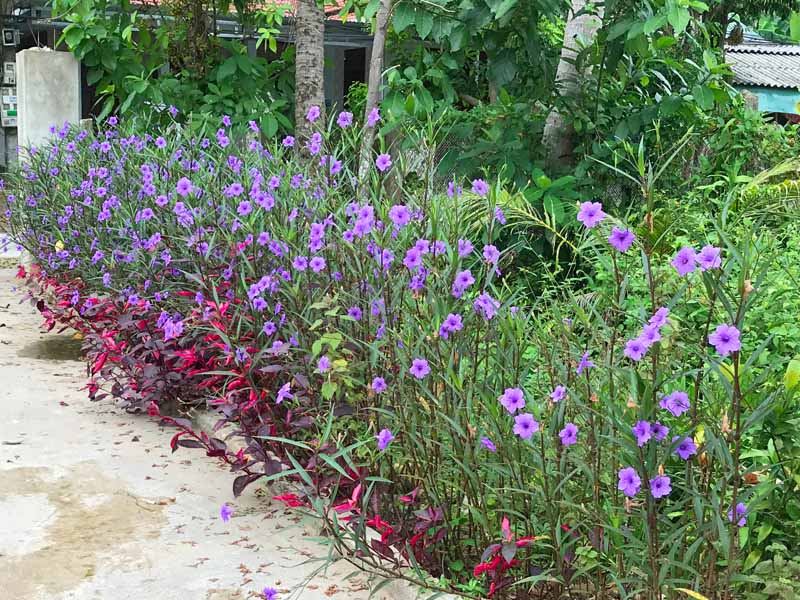
Interestingly, the stem of this plant becomes more purple when it’s in bright light, as opposed to when it’s grown in a shady area, where the stem stays fairly green.
I’ve always used my Mexican petunia as a shade plant and was surprised to see purple-stemmed ruellia on a visit to Tucson, Arizona, where it was planted in full sun.
Cultivation and History
As with so many of our favorite botanicals, this one comes with a host of aliases.
Though not closely related to petunias, many know the plant as Britton’s wild, Texas petunia, or sometimes even Mexican bluebell.
Scientifically, it’s been labeled R. brittoniana, R. coerulea, R. malacosperma, and R. tweediana, though today’s taxonomists are in agreement that R. simplex is the correct moniker.
The plant is native to Mexico and South America, and has naturalized in Hawaii and from South Carolina to Texas, where gardeners appreciate it greatly.
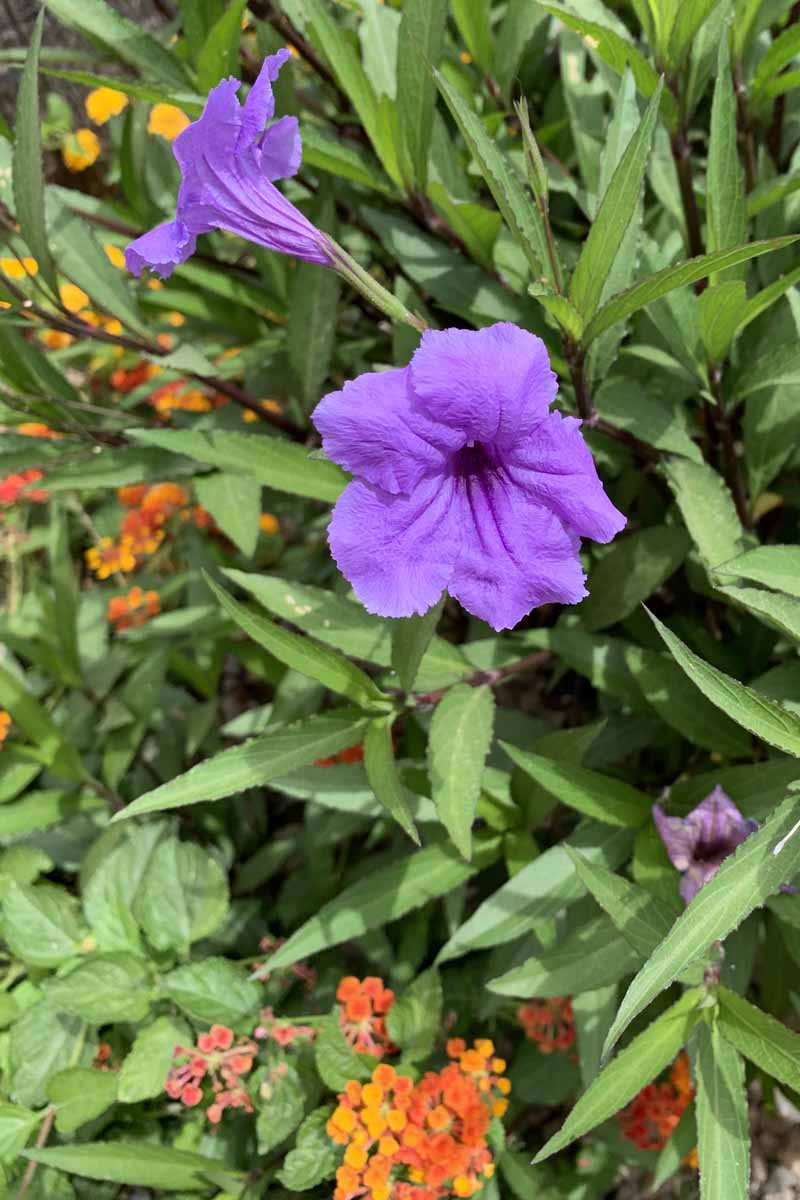
Butterflies like it too – it attracts swallowtail, brush-footed, and monarch butterflies eager to enjoy the flowers’ nectar.
However, as alluded to above, it is considered invasive in Florida.
There, like a septuagenarian Minnesotan in January, it has populated freely, and the locals RUE(llia) the day it was introduced.
It has a tendency to crowd out native Florida species, and so local horticulturists strongly warn against its use.
The plant is named for Jean de la Ruelle, a late 15th- to early 16th-century French herbalist and physician to King Francois.
Propagation
Mexican petunia spreads naturally by both seeds – it can spew the small brown discs as far as ten feet – and rhizomes.
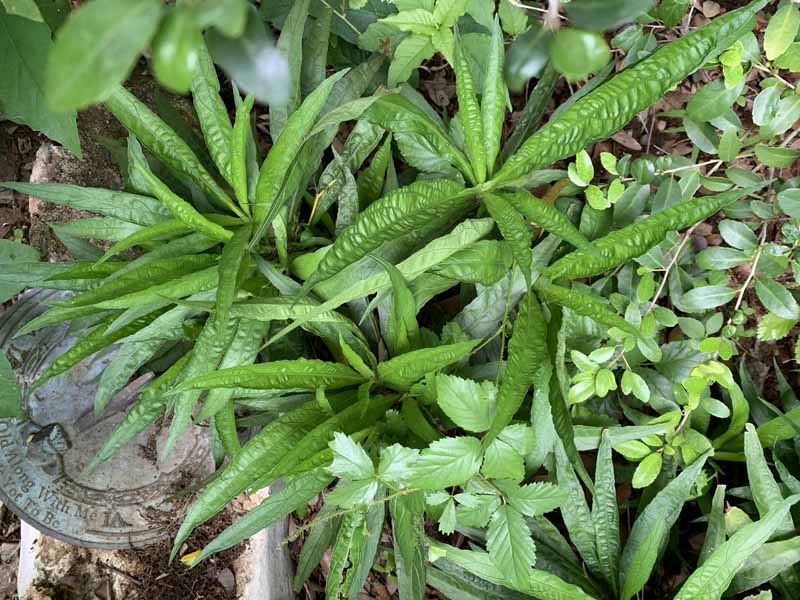
You can also propagate this plant via purchased seeds, cuttings, or division.
From Seed
Sow R. simplex seeds in early spring, after all danger of frost has passed. Plant one to two seeds for each expected plant, spaced 12 inches apart.
From Cuttings
If you want even more plants – in a different part of the yard, for example – you can propagate by taking cuttings in springtime.
With a sharp, clean blade, cut a healthy-looking stem just below a node, four to six inches from the end. Strip off any leaves near the bottom of the stem, and remove the bloom.
Prepare a clean four-inch pot with a mix of perlite and peat moss and moisten the mixture. Make a two-inch-deep hole in the potting mix with a pencil.
Dip the cut end of the cutting into a powdered rooting hormone, and place the cutting into the hole you made in the potting mix.
Place your potted cuttings in bright, indirect light, and keep them moist. After roots are established, you can transplant them outside.
Division
To divide this plant, loosen the soil around the area, and then dig around the clump you wish to excise.
Lift out the clump and, using a shovel, slice the crown of the plant into several pieces.
Place your transplants into holes the same depth as the root balls of your clumps and twice as wide. Spread the roots out in the holes.
Cover the roots with dirt and water thoroughly; continue to water well for several weeks until well-established.
Get more details about dividing perennials here.
How to Grow
Mexican petunia is generally highly prized as a shade plant, but if your summers aren’t too brutal, the plant may be able to take full sun.
It is drought tolerant, and in fact, throughout our brutal Central Texas summers, I give mine nary a drop of supplemental water and they do just fine.
However, the plant does even better in wet conditions (hello, Florida!).
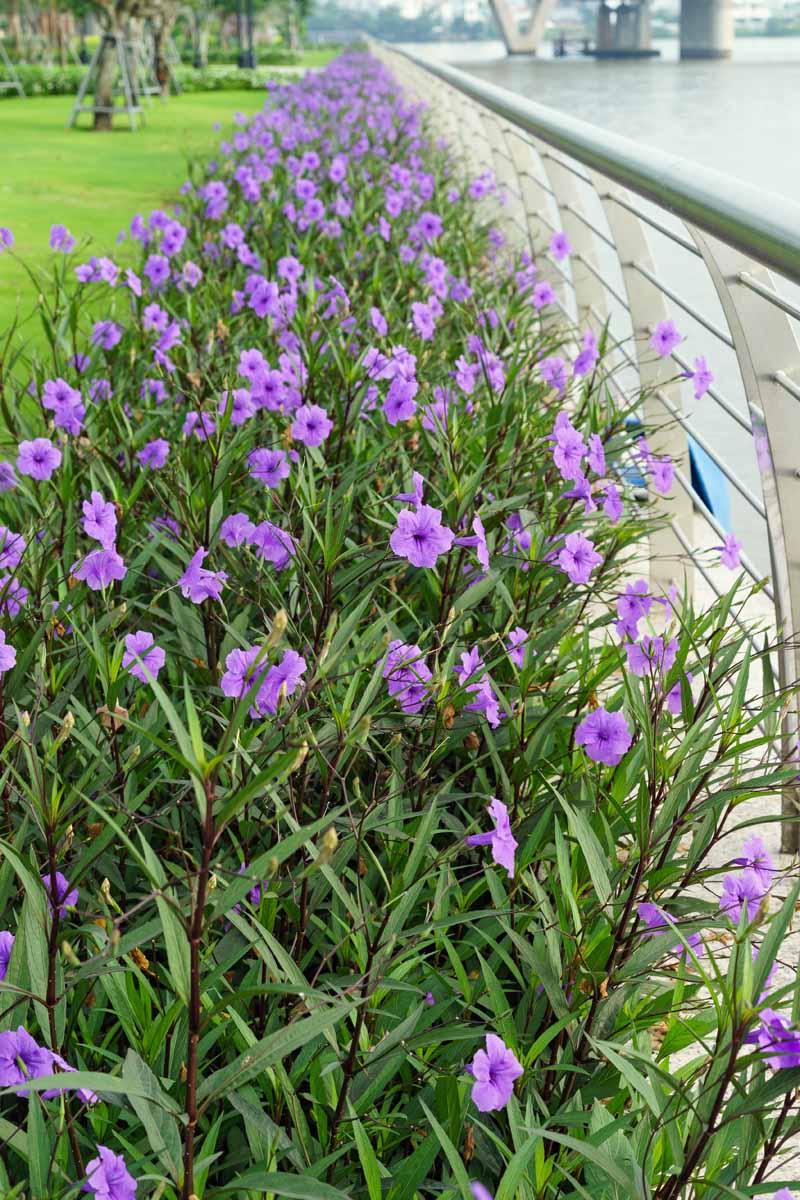
As with most plants, you’ll want to treat them to regular, deep waterings immediately after transplanting, which you’ll do in springtime, and then you can back off the watering if you like.
You can baby the plant with rich compost or you can stick in the native soil that’s already there, and it will still do fine.
Fertilize with a 10-10-10 (NPK) mixture in springtime. Or don’t. See a theme here?
Growing Tips
- Don’t plant in full sun if the heat is brutal where you live
- Give the plant extra water right after you plant it
- Plant in sun or shade
Pruning and Maintenance
Trim out any dead leaves and remove dead flowers for aesthetic purposes. Cut off the seed pods if you don’t want the plant to spread its seeds.
You can dry and save them for planting elsewhere if you wish, or trade with the neighbors.
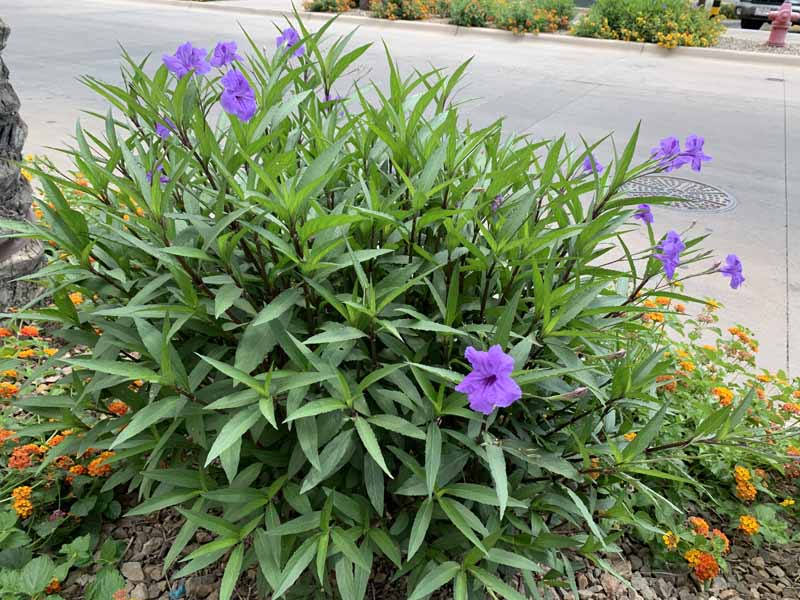
Of course, if your R. simplex spreads too far and wide, you can excise the metastasizing plants.
Cultivars to Select
Several cultivars are available, with the distinguishing characteristic typically being flower color.

Ruellia Rooted Live Plants via Amazon
A notable and popular cultivar differs from the straight species in its height.
While most standard forms of Mexican petunia range in height from 18 to 36 inches, ‘Katie’s Dwarf’ ranges from eight to 12 inches tall.
This variety is less aggressive than its taller cousins, though mine definitely spreads.
‘Chi Chi’ is a popular pink cultivar often found at plant centers.
Southern Star ‘Pink’ features delicate, light pink flowers with darker centers. This is a dwarf variety, topping out at 10 to 12 inches tall.
You can find packages of 30 seeds available via Walmart.
And if white is more your style, Southern Star ‘White’ is another dwarf cultivar that makes a delightful ground cover.
Walmart carries packets of 30 seeds.
Floridians, if you’re still with us, you should choose the cultivar ‘Purple Showers,’ which is sterile and does not produce seed.
It can still spread via rhizomes, however.
Managing Pests and Diseases
It’s not on the menu for deer, but if these graceful herbivores are helping themselves to other plants in your garden, check out this article about protecting your plants.
R. simplex doesn’t have any notable insect pest or disease concerns to worry about, either.
Best Uses
Mass plantings of the tall type make a nice border for the back of your beds, whereas the shorter variety makes a lovely edging plant.
You also might want to use this plant to add some color to shady areas.
Quick Reference Growing Guide
| Plant Type: | Perennial | Flower Color: | Purple/violet |
| Native to: | Mexico and South America | Maintenance: | Minimal |
| Hardiness (USDA Zone): | 8-11 (marginally hardy in Zone 7 with protection) | Tolerance: | Drought |
| Bloom Time: | Spring, summer, fall | Soil Type: | Any |
| Exposure: | Sun or shade | Soil pH: | Any |
| Time to Maturity: | 1-2 months | Soil Drainage: | Well-draining |
| Spacing: | 12 inches | Companion Planting: | Lantana |
| Planting Depth: | 1/4 inch | Uses: | Tall type - borders and mass plantings Dwarf type - edging |
| Height: | 8-12 inches (dwarf type) 18-36 inches (tall type) | Attracts: | Butterflies (swallowtail, brush-footed, and milkweed) and hummingbirds |
| Spread: | 24-36 inches | Family: | Acanthaceae |
| Water Needs: | Moderate to low | Genus: | Ruellia |
| Pests & Diseases: | Spider mites | Species: | simplex |
Purple Power
Floridians notwithstanding, gardeners in the southern United States would do well to add this purple-blooming beauty to their gardens.
A lovely tall plant for the back of a bed, or a pretty edging for the front — one species, two practical uses.
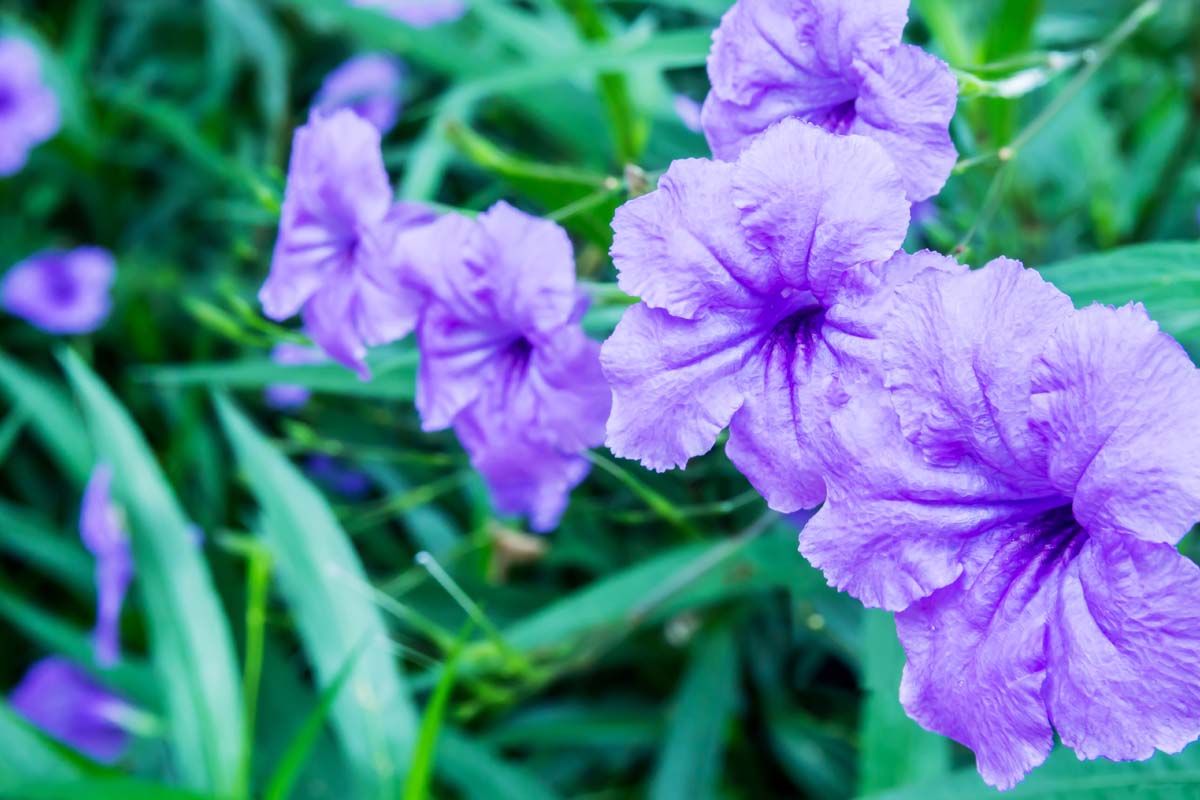
Virtually maintenance-free and pest-free, and requiring hardly any attention, R. simplex is a lovely addition to any garden.
Are you in the pro- or anti-ruellia camp? Share your experience with this pretty plant in the comments section below.
And for more information on plants that thrive in the shade, check out these guides next:
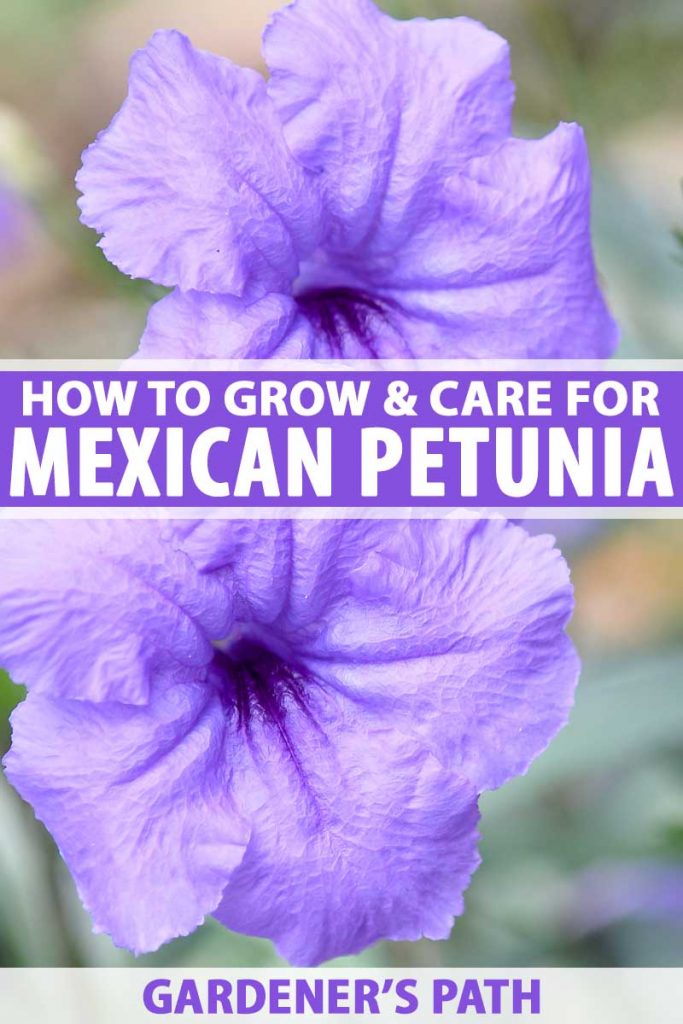
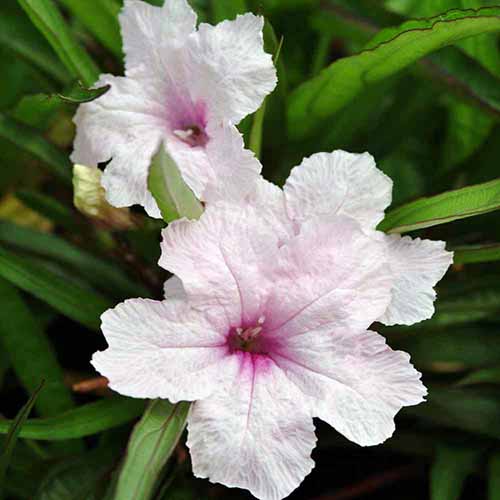


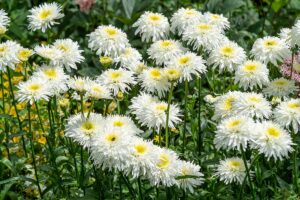
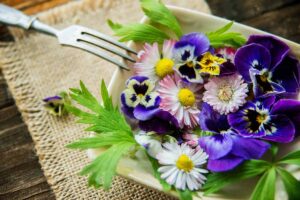
I have the purple variety bought it at Lowe’s. I want white and pink and if any other colors are available.
Hi Sue! I’ve seen purple, pink and white, but no other colors. You may have to go online to purchase varieties other than what your local stores carry.
I have all colors, red, white, pink and lavender
I bet they’re beautiful, Ismael. Post a photo!
Check Etsy. Get cuttings; they’re cheaper and grow great in water. Then plant them where you want them. They’re tough.
These are beautiful plants that stay full of blooms. I love the lacy leaves.
Hi Cathy! Yes, they do bloom a lot, don’t they! I like the leaf form, also. Do you have these in your garden?
I broke off a few sprigs from a neighbor’s stand of Mexican petunia about 20 years ago and rooted them in water. I now have a massive border of my own that blooms continually spring through late fall in the South Central Texas sunshine. No special care needed. I’m going to have to cut it back and dig some out to keep it in bounds…it goes where it wants. Hummingbirds love it.
Wow! Sounds gorgeous, Rob. Nice of your neighbor to share; maybe you can pay it forward when you do your pruning!
can u share pictures please .trying to get an idea for my bed.
I love the ones I planted last week.
Awesome! We’d love to see photos!
Honeybees love them—and what’s good for the bees is good for the world.
Yes! Absolutely! Thanks for mentioning this!
They are great for attracting hummingbirds, too!
Edit: Then I noticed Rob’s mentioning that, as well. Haha!
Hi Voodoo! No worries! It’s so cool it’s worth mentioning many times!
The first cold front hit Dallas (mid-October ) – so mine just finished blooming for the year. They also attract bees and it’s entertaining to watch them crawl down into the flowers and disappear. Also we grow ours by the pool so the majority of the daily flowers that fall out will float in the pool and stay purple for a few hours – so pretty.
One question – after they have died off in the winter – do you pull them up or cut them down – what’s the best method to get ready for the spring?
Hi bbkahlich! Thanks for reading. I know… can you believe our crazy weather? In Austin, I do nothing to mine for winter. Once in a great while, they freeze to the ground, but then come back in spring. But mostly they just sit there all winter, looking fine. No flowers, but the leaves are fine. I can picture the blooms in the pool, btw! Sounds beautiful!
I cut them down to about 6 inches above ground after the first freeze. They grow back in the spring. I also live in Dallas.
Great to know, Elise! You’re just far enough north of us here in Austin that a slightly different care routine is in order.
We are fortunate to have a beautiful array of them in a small patch of dirt outside our apartment in Dallas that is maintained by a lawn crew. It gets morning sun and afternoon shade facing the east. And in this climate, we typically see the greenery fade to brown twigs for the really cold part of the year, but the greenery lasts really really far, I’m pretty sure to November or more. And for two of the past 3 years, the lawn crew took the weed whacker to em until they were nothing but 4-6 inches of brown twigs.… Read more »
I have them in a front landscape bed, in Central Arkansas. Location is facing east with strong sun in the summer until about 2-3 p.m., then shade from the house. Mine die off (above ground) in winter, so I cut the woody stem to about 2″ and cover with mulch. They come back in early spring, and boom all summer. I’ve recently taken some of the ‘volunteers’ and put them in large pots in the backyard. They bloomed the same week that I transplanted them, so definitely hardy!! My favorite plant!!!
I live in Northern Virginia and planted Mexican Petunias this late fall. I did not know the name of this plant & not knowing about it left it in the ground. Should I bring them inside or are they hardy enough to grow in our zone? I loved the blooms and rich color.
thanks for your help!
I wasn’t a fan of these because the former owners of my house planted them as a patio edge, and I think they look awkward there. Now that I know they can live in shade, I’m going to dig them up and move them to the shade garden I’m putting in! Yay!
What a fabulous solution, Emily. You will be happy and the plants will be happy!
I have a ground cover that I must keep tamed. Can I plant these in them here? The ground cover is around my tree in a shaded area of course.
Yes! That sounds like a great place for these plants, LaJuana!
I got a pot of Mexican petunia in the spring. I have kept it in a large pot on my sunny back patio. It has produced only one bloom!That was yesterday. What have I done wrong? I live in NC. We’ve had a hot summer.
Barbara, that sounds frustrating! The pot gets a good 6 hours of sun a day? You might need to add a phosphorus-heavy fertilizer and see if that increases blooming
Same here with me. I live in TN and get less than 10 blooms a year. It gets sun for around 6 hours a day. I will try the fertilizer and see if it works.